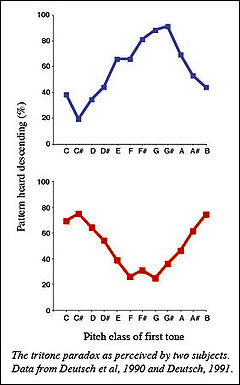
Tritone paradox
Encyclopedia

Auditory illusion
An auditory illusion is an illusion of hearing, the aural equivalent of an optical illusion: the listener hears either sounds which are not present in the stimulus, or "impossible" sounds...
in which a sequentially played pair of Shepard tone
Shepard tone
A Shepard tone, named after Roger Shepard, is a sound consisting of a superposition of sine waves separated by octaves. When played with the base pitch of the tone moving upward or downward, it is referred to as the Shepard scale. This creates the auditory illusion of a tone that continually...
s separated by an interval
Interval (music)
In music theory, an interval is a combination of two notes, or the ratio between their frequencies. Two-note combinations are also called dyads...
of a tritone
Tritone
In classical music from Western culture, the tritone |tone]]) is traditionally defined as a musical interval composed of three whole tones. In a chromatic scale, each whole tone can be further divided into two semitones...
, or half octave, is heard as ascending by some people and as descending by others. Different populations tend to favor one of a limited set of different spots around the chromatic circle
Chromatic circle
The chromatic circle is a geometrical space that shows relationships among the 12 equal-tempered pitch classes making up the familiar chromatic scale...
as central to the set of "higher" tones. The tritone paradox was first reported by psychology of music
Music psychology
Music psychology,or the psychology of music, may be regarded as a branch of psychology or a branch of musicology. It aims to explain and understand musical behavior and musical experience...
researcher Diana Deutsch
Diana Deutsch
Diana Deutsch is a British-American perceptual and cognitive psychologist, born in London, England. She is currently Professor of Psychology at the University of California, San Diego, and is one of the most prominent researchers on the psychology of music...
in 1986.
Each Shepard tone consists of a set of octave related sinusoids, the amplitudes of which are scaled by a fixed bell shaped spectral envelope based on a log frequency scale. For example, one tone might consist of a sinusoid at 440 Hz, accompanied by sinusoid at the higher octaves (880 Hz, 1760 Hz, etc.) and lower octaves (220 Hz, 110 Hz, etc.). The other tone might consist of a 311 Hz sinusoid, again accompanied by higher and lower octaves (622 Hz, 155.5 Hz, etc.). The amplitudes of the sinusoids of both complexes are determined by the same fixed amplitude envelope - for example the envelope might be centered at 370 Hz and span a 6 octave range.
Shepard predicted that the two tones would constitute a bistable figure, the auditory equivalent of the Necker cube
Necker cube
The Necker Cube is an optical illusion first published as a rhomboid in 1832 by Swiss crystallographer Louis Albert Necker.-Ambiguity:The Necker Cube is an ambiguous line drawing....
, that could be heard ascending or descending, but never both at the same time. Diana Deutsch later found that perception of which tone was higher depended on the absolute frequencies involved: an individual will usually find the same tone to be higher, and this is determined by the tones' absolute pitches. This is consistently done by a large portion of the population, despite the fact that responding differently to different tones must involve the ability to hear absolute pitch
Absolute pitch
Absolute pitch , widely referred to as perfect pitch, is the ability of a person to identify or re-create a given musical note without the benefit of an external reference.-Definition:...
, which was thought to be extremely rare. This finding has been used to argue that latent absolute-pitch ability is present in a large proportion of the population. In addition, Deutsch found that subjects from the south of England and from California resolved the ambiguity the opposite way. Also, Deutsch, Henthorn and Dolson found that native speakers of Vietnamese
Vietnamese language
Vietnamese is the national and official language of Vietnam. It is the mother tongue of 86% of Vietnam's population, and of about three million overseas Vietnamese. It is also spoken as a second language by many ethnic minorities of Vietnam...
, a tonal
Tone (linguistics)
Tone is the use of pitch in language to distinguish lexical or grammatical meaning—that is, to distinguish or inflect words. All verbal languages use pitch to express emotional and other paralinguistic information, and to convey emphasis, contrast, and other such features in what is called...
language, heard the tritone paradox differently from Californians who were native speakers of English.

